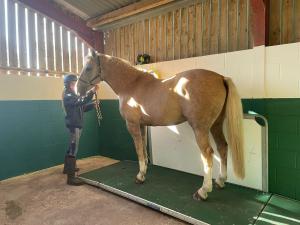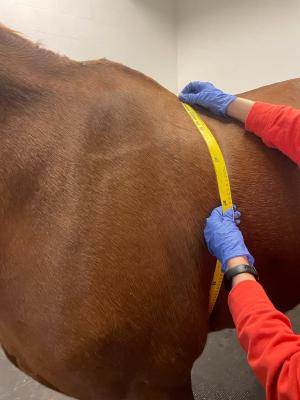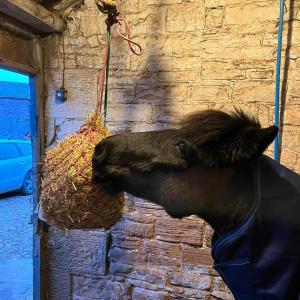
By Vet Selina Squarotti
Being overweight is one of the most serious and life-threatening issues a horse can have.
It increases the risk of heart and lung diseases and arthritis, and it has a direct link to laminitis, which is one of the most common causes of euthanasia in equine practice.

Before domestication, horses lived as grazers, covering many miles daily and they were either growing, pregnant, with foal at foot or mating.
In the wild, horses eat a large amount of grass in summer, converting it to fat to survive the winter when there is no grass growth.
Today, this metabolic mechanism still operates. Many horses enter the winter being fat, but the ‘winter lean period’ never arrives, because they then get rugged and overfed instead.
This all contributes to the so called ‘Equine metabolic syndrome’ where obesity, insulin resistance and increased circulating cortisol will, in many cases, lead to laminitis.
All horses should be managed with a combination of the right diet, regular and suitable exercise, and good health care to maintain a healthy body weight.
Tools for assessing body weight and condition are a weighbridge, weigh-tape and body scoring.

Weigh-tapes can be frustrating, but for every kilogram of fat that can be seen on the outside of the horse, there is another one on the inside around its organs. Horses tend to lose the internal fat first, so it is important not to be discouraged if not much difference can be seen.
The same tape should be used for each measurement, making sure the horse is taped by the same person, in the same place and at the same time of day each time.
Body scoring is the most practical way to assess the body weight of a horse. The easiest system scores horses from 0 to 5, 0 being emaciated, 3 being healthy and 5 being obese.
Fat tends to build up on neck, especially the crest, wither and back bones, behind the shoulders and where the shoulders meet the neck, on the ribs, the point of the hip, tail head and rump.
For any horse scoring 4.5 and above or a laminitic of 3.5 or above, grazing should be stopped. It may seem drastic, but your horse’s health is at risk. Only hay (soaked if laminitic) and a low calory balancer should be fed.
Hay should be weighed and the total ratio per 24 hours for an obese horse that has not had laminitis is 1.5% of the current body weight, 1.3% for a laminitic.
Not being allowed access to grass might limit horses’ natural behaviour. To avoid boredom, they should be allowed to spend more time on the yard, in the arena or dry paddocks or can be stabled in different pens for day and night.

To slow down the eating, the hay net could be hung in the centre of the stable, rather than against the wall and hay can be double netted.
Once the horse reaches a body condition of 3.5-4, grazing can be slowly reintroduced, but limited.
Grazing muzzles can reduce the amount horses can eat by 50%, without stopping them from eating. Horses are very adaptable and grazing muzzles are no more abnormal than being ridden, stabled or rugged!
Whenever possible, exercise should be increased, and rugging reduced. Overweight horses have plenty of fat to keep them warm and cold weather should be used to let horses naturally burn off fat to keep warm (shivering). And it is more important to provide horses with access to a shelter if outside for long period, than rugging.
Lastly, horses on a diet might appear unhappy, but obesity is a dangerous disease. It is important to understand what horses need and how they were designed to live, to provide them with a better life.